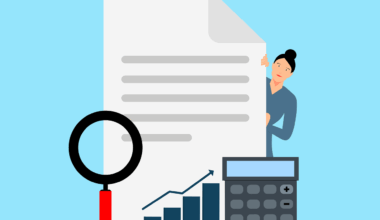Quantitative Methods for Business Decision Making
In today’s competitive business environment, organizations use quantitative methods to enhance decision-making processes. These methods rely on statistical data to provide insights that lead to effective strategic choices. By utilizing various models, businesses can identify trends, forecast future performance, and analyze market behaviors. Econometrics specifically incorporates economic theories and quantitative data, offering a robust framework for evaluation. The correct application of these methods can significantly reduce uncertainties in business planning. For example, regression analysis helps businesses to understand the relationship between variables, such as marketing expenditures and sales revenue. Using this analysis, firms can optimize budgets and allocate resources more effectively. Similarly, time series analysis allows businesses to examine patterns over time, enabling them to predict sales cycles and seasonal trends. In conclusion, quantitative methods empower organizations to make informed decisions backed by data and solid evidence, essential for navigating the complexities in today’s economy.
The essence of quantitative methods lies in their systematic approach to problem-solving. Organizations often face numerous challenges, from budget constraints to market saturation. Utilizing econometric techniques allows for a structured evaluation of these issues. A key advantage is the ability to perform what-if analyses, where potential scenarios are examined to determine likely outcomes corresponding to various business strategies. This analysis can aid in resource allocation, pricing strategies, and even entering new markets. The advent of technology has further facilitated quantitative methods, as software tools now make complex calculations manageable. Businesses can gather vast amounts of data and analyze them efficiently. However, the challenge is ensuring that data quality remains high; inaccurate data can lead to misleading conclusions. A robust data management system is essential to filter, validate, and interpret the information accurately. Moreover, organizations must continuously update their datasets to keep pace with market dynamics. To summarize, the intersection of technology and econometrics fosters an environment where businesses can thrive through informed decision-making based on solid quantitative evidence.
A Practical Application of Econometrics
One of the most practical applications of econometrics in business is in pricing strategies. Businesses must regularly adjust prices to respond to shifts in market conditions, customer preferences, and competitor actions. Econometric models can assist in predicting the impact of price changes on sales volume. For instance, using demand elasticity analysis helps firms determine how sensitive customers are to price changes. This can inform pricing strategies such as discounts or premium pricing, ensuring maximum profitability while maintaining customer satisfaction. Moreover, businesses can utilize cluster analysis to segment consumers based on their purchasing behaviors, allowing for targeted marketing efforts. This tactic increases marketing efficiency and improves return on investment. Tracking the effectiveness of these strategies can be facilitated through multidimensional scaling, which helps visualize customer preferences and market presence. As firms adopt these quantitative methodologies, they not only enhance their understanding of the market but also build a competitive advantage. In closing, the integration of econometric models in pricing strategies is vital for thriving in today’s complex market landscape.
Forecasting demand accurately is another essential element of quantitative methods for business decision-making. Organizations aim to maintain an optimal balance between supply and demand, preventing excess inventory or stock shortages. Techniques like time series analysis enable businesses to analyze historical data patterns, providing a basis for future predictions. By assessing historical trends, seasonal effects, and cyclical patterns, econometrics facilitates improved demand forecasting. For example, retail businesses often leverage these methods to predict sales during specific periods such as holidays or promotional events. This foresight allows businesses to mobilize resources accordingly, ensuring they meet customer demand without sacrificing profitability. Additionally, employing advanced methodologies like ARIMA (AutoRegressive Integrated Moving Average) can yield more accurate forecasts by accounting for varying data behaviors. However, data normalization and adjustments for outliers play a crucial role in enhancing forecast reliability. Ultimately, precise demand forecasting results in optimized inventory management and superior customer experiences. In summary, organizations equipped with robust forecasting methodologies can make smarter operational decisions and maintain their competitive positioning.
Risk Assessment Through Quantitative Models
In the context of decision-making, risk management is critical. Quantitative methods offer businesses a means of evaluating risks systematically. By employing statistical models, organizations can assess the probability of various risk factors impacting their operations. For instance, credit risk modeling helps financial institutions evaluate the likelihood that a borrower will default on a loan. Understanding these probabilities enables organizations to create appropriate strategies for risk mitigation. Furthermore, scenario analysis generates insights into potential business outcomes under various conditions, equipping managers with knowledge about the uncertainties they might face. The Value at Risk (VaR) model also allows firms to estimate the potential loss in a portfolio, guiding investment choices. However, while quantitative methods provide valuable insights, they are not devoid of limitations; reliance on historical data weaknesses can mislead forecasts. Thus, businesses must combine quantitative assessments with qualitative judgment. By integrating both approaches, firms can enhance risk understanding and form comprehensive strategies. In conclusion, the application of quantitative risk assessment methods is fundamental for informed decision-making in any business sector.
Moreover, the importance of effective communication of quantitative findings cannot be overstated. Analysts must convey complex data insights in a format that stakeholders understand. This often involves designing visual aids such as graphs, charts, and dashboards that present data succinctly. The clarity of visual representation enhances comprehension and facilitates discussion, aligning everyone with the data-driven strategies presented. Businesses can utilize software packages that specialize in data visualization, ensuring that data interpretations lead to actionable insights. Additionally, storytelling techniques can significantly enhance data reporting by framing insights within narrative contexts that resonate with stakeholders. Engaging presentations can transform raw data into compelling business stories, making it far easier to justify decisions based on quantitative analysis. Consequently, effective communication is vital to ensuring that strategic decisions are both accepted and implemented. It fosters a culture where data-driven insights are embraced within the organization’s strategic framework. To sum up, presenting quantitative analysis results in an engaging manner is crucial in turning insights into decisive actions for business success.
The Future of Quantitative Methods in Business
As businesses face increasing complexity, the future of quantitative methods appears promising. Innovations in data analytics and machine learning are poised to enhance methodologies further. These advancements will make it possible to analyze larger datasets with improved accuracy and speed, generating more precise insights than ever before. Consequently, organizations must adapt their frameworks to incorporate these new techniques effectively. Businesses can harness tools like artificial intelligence for predictive analytics, further refining decision-making processes. Moreover, the integration of big data promises to revolutionize how companies approach and utilize econometric methods. Utilizing real-time data opens up possibilities for dynamic forecasting and on-the-fly adjustments to operational strategies. It is imperative for companies to invest in technology and talent to leverage these emerging methodologies, ensuring they remain competitive. Continuous evolution of quantitative skills among employees will be necessary to understand and effectively apply advanced models. Overall, embracing technological innovations will ensure that businesses can utilize quantitative methods to their fullest potential in navigating future challenges.
Lastly, establishing a culture that values continuous learning in quantitative methods is vital. Organizations must cultivate environments where employees feel empowered to explore data-driven decision-making and enhance their quantitative skills. Offering training programs, workshops, and access to online resources can foster interest and proficiency in econometric methods. Encouraging collaboration between departments will also facilitate knowledge-sharing and enhance analytical capabilities across the organization. A strong quantitative foundation not only aids in data analysis but also supports businesses in proactively adapting to market changes. Companies can benefit greatly by embedding a data-centric philosophy into their organizational DNA. Research suggests that firms that harness data extensively tend to outperform their competitors in the long run. The opportunity thus lies in creating an agile workforce capable of leveraging quantitative insights to drive innovation. Transitioning into this data-centric approach demands both leadership commitment and investment in resources. Ultimately, nurturing a data-driven culture will empower organizations to thrive in the evolving economic landscape by making informed and sound business decisions.


